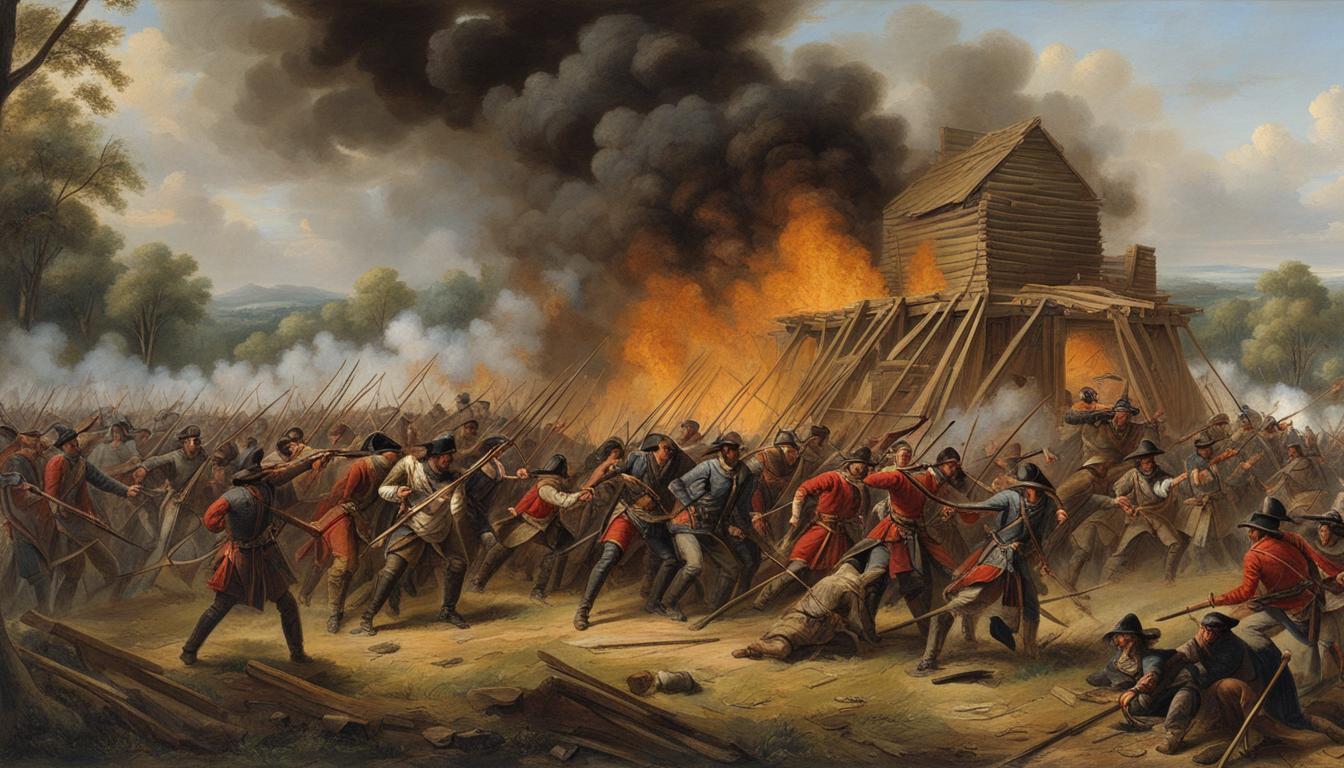The Siege of Boonesborough, a pivotal battle in Revolutionary War history, unfolded from September 7 to September 18, 1778, in Kentucky, culminating in a triumphant American defense. Shawnee Chief Blackfish, in league with the British, orchestrated an assault on the frontier settlement previously founded by Daniel Boone. Though vastly outnumbered by Blackfish’s 444 Native Americans, 12 militiamen from various tribes, and Detroit French-Canadian forces, Boone’s leadership galvanized the settlers into a formidable defense, illustrating the endurance and resolve of frontier America in the face of adversity during the American Revolutionary War.
Key Takeaways
- The Siege of Boonesborough occurred from September 7-18, 1778, in Kentucky, with Shawnee Chief Blackfish leading the attack on the settlement established by Daniel Boone.
- Though greatly outnumbered, the fortified American settlers successfully defended Boonesborough, marking an important victory in the American Revolutionary War and frontier America.
- Daniel Boone’s leadership and strategic thinking were crucial in orchestrating Boonesborough’s defense, proving his invaluable contributions to American history.
- Shawnee involvement in the siege, backed by British forces, highlighted the broader geopolitical significance of Boonesborough in the conflict.
- Today, Boonesborough remains an essential historical site, with yearly reenactments preserving the story of the siege and the spirit of the American frontier.
Introduction to the Siege of Boonesborough
The Siege of Boonesborough began on September 7, 1778, as Shawnee Chief Blackfish and his formidable force targeted the Boonesborough settlement for capture. Daniel Boone, who had previously been adopted by the Shawnee following his capture and escape, returned to galvanize and lead the settlers’ defense, culminating in a multi-day standoff that ultimately ended in failure for the attackers and regarded as an American victory within the larger context of the Revolutionary War.
Frontier settlements like Boonesborough played a crucial role in America’s westward expansion, as they served as strategic locations for settlers’ defense against Native American attacks. In many cases, these settlements were established against the wishes of Native tribes, leading to tensions and conflicts, such as the Siege of Boonesborough.
“The spark that ignited the conflict was the relentless drive of settlers into the region, which was regarded by Native tribes as their hunting grounds.” -Historian James Alexander Thom.
Let’s take a closer look at the key figures and events that shaped the course of the Siege of Boonesborough:
- Daniel Boone: Legendary frontiersman and the founder of Boonesborough. Boone’s leadership, wilderness skills, and intimate knowledge of the region were crucial to the settlers’ successful defense of the settlement.
- Shawnee Chief Blackfish: The primary antagonist of the siege, Blackfish led the Native American force allied with the British in an attempt to capture Boonesborough and drive out the settlers.
- Frontier Settlements: Communities like Boonesborough that served as outposts for American colonists during their westward expansion.
- The Revolutionary War: The broader historical context within which the Siege of Boonesborough took place, with the conflicts between settlers and Native tribes forming part of the larger struggle for American independence.
Contemporary accounts from the time portray the siege as a harrowing ordeal for the settlers, who faced seemingly insurmountable odds against a well-organized and equipped enemy force.
| Event | Date |
|---|---|
| Daniel Boone establishes Boonesborough | 1775 |
| Boone’s capture by Shawnee Chief Blackfish | 1778 |
| Boone learns of the planned attack on Boonesborough and escapes | August 1778 |
| The Siege of Boonesborough begins | September 7, 1778 |
| The Siege of Boonesborough ends | September 18, 1778 |
Although the Siege of Boonesborough was a localized conflict, it carried significant implications for the course of the Revolutionary War and the fate of countless frontier settlements that represented America’s burgeoning western expansion. The settlers’ ultimately successful defense of their home in the face of adversity and overwhelming odds reinforced the spirit of persistence and resilience that would ultimately help to define the character of the nation they sought to build.
The Strategic Importance of Boonesborough
As a crucial frontier settlement, Boonesborough held significant value for colonists during the Revolutionary War era. Its foundation by Daniel Boone, under the direction of Richard Henderson, marked the beginnings of the settlement of Kentucky, which would later alter the course of colonial history.
Boonesborough as a Frontier Settlement
Established under the ambitious colonization project of Transylvania orchestrated by Richard Henderson, Boonesborough emerged as an important hub for families seeking fertile land and new opportunities in the west. Following its incorporation into Virginia in 1776, the settlement attracted numerous settlers, despite the unease amongst the Shawnee and neighboring tribes who saw their hunting grounds transformed into colonial territory.
Boonesborough represented a triumphant colonization effort, laying the groundwork for modern-day Kentucky.
Geopolitical Significance during the Revolutionary War
Boonesborough’s prime location near the Kentucky River and its role as a major defensive fort during the American Revolutionary War added to its geopolitical importance. It stood at the edge of western Virginia’s territorial expansion, with the Ohio River marking a disputed boundary between Shawnee land and colonial claims. Furthermore, the British strengthened their alliance with the Native American tribes by supporting their raids on colonial settlements, as evidenced by figures like Henry Hamilton.
| Strategic Factor | Description |
|---|---|
| Kentucky River Proximity | Boonesborough’s closeness to the Kentucky River provided a natural defense barrier and facilitated transportation and trade. |
| Revolutionary War Frontier | Boonesborough was one of the primary defensive forts during the Revolutionary War, reinforcing the frontier settlements. |
| Western Virginia Boundary | Located along the contentious western edge of Virginia, Boonesborough stood at the center of the territorial disputes between colonists and Native American tribes. |
| British Alliance | The British supported Native American efforts to regain their lost territories and weaken colonial defenses, adding to Boonesborough’s strategic value in the conflict. |
In conclusion, Boonesborough’s strategic importance as a frontier settlement and its role in shaping the course of the Revolutionary War cannot be overstated. From its beginnings as part of Richard Henderson’s colonization efforts to its eventual prominence as a crucial defense post, the settlement played a vital role in the development of the western frontier and the establishment of Kentucky.
A Snapshot of Frontier Life at Boonesborough
Frontier life at Boonesborough was defined by its settlers’ determination to thrive in the face of adversity and the ever-present threat of Native American raids. Settlers constructed and lived within the protective confines of the fort, which also served as the venue for significant community events, including legal proceedings and negotiations with Native tribes.
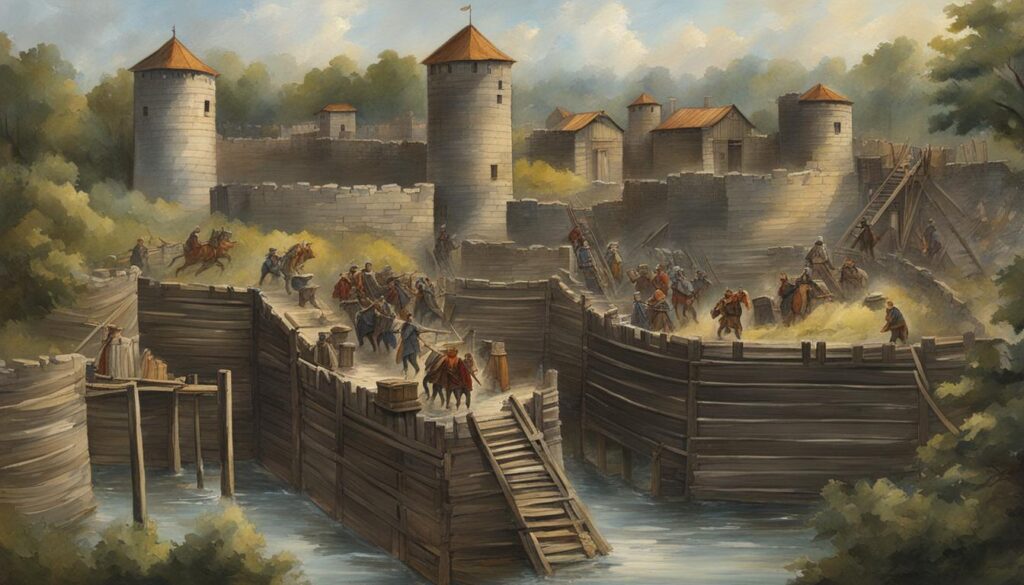
With Kentucky settlements becoming more common, the settlers leaned on each other to protect themselves from the dangers that surrounded these isolated communities. They relied on robust fortifications and strategic frontier defense measures to safeguard their lives.
“The fortifications were both a home and a bulwark against the dangers that surrounded the isolated settlements.”
- Construction of Fortifications: The settlers built a strong and secure fort to protect themselves against potential raids, providing a safe haven and effectively defending the community.
- Defensive Strategies: The settlement employed various techniques, such as vigilant patrols and guard posts, to pre-empt potential threats and maintain the safety of their families.
- Community Cohesion: Boonesborough residents fostered a sense of unity and camaraderie, collectively participating in activities like legal proceedings and conflict resolutions with Native tribes.
Boonesborough’s frontier life exemplifies the resourcefulness, resilience, and collaboration among settlers who strove to survive and prosper in the challenging landscape of the expanding American frontier.
| Aspect | Description |
|---|---|
| Fortifications | Settlers constructed and maintained a secure fort to protect their community from potential threats, utilizing innovative defense techniques when necessary. |
| Community Life | A strong sense of camaraderie and collective responsibility characterized the community, with settlers working together to ensure their safety and preserve their way of life. |
| Frontier Defense | Through strategic defense measures and cooperation, the settlers displayed unwavering dedication to their community’s safety and prosperity. |
Thus, the snapshot of Boonesborough’s frontier life reveals a community forged in the unyielding spirit of self-reliance, courage, and steadfast resolve in the face of the ever-present danger.
Daniel Boone: A Pioneer and Leader Under Siege
Daniel Boone’s leadership during the siege of Boonesborough was built on a foundation of his own experiences, trials, and triumphs in the frontier. His strategic thinking and wilderness skills were invaluable to the settlers, helping to shape their defense against the onslaught.
Boone’s Capture and Escape: A Prelude to the Siege
In 1778, Daniel Boone was captured by a band of Shawnee warriors under the guidance of their fearsome leader, Blackfish. In a remarkable turn of fate, Boone would be adopted into the tribe and given the name Sheltowee, meaning “Big Turtle.” However, his loyalty would remain ultimately with Boonesborough.
Boone managed to escape upon learning of Blackfish’s intentions to attack Boonesborough, making a daring and ingenious dash back to the settlement, covering 160 miles of treacherous terrain to warn his compatriots and prepare their defenses.
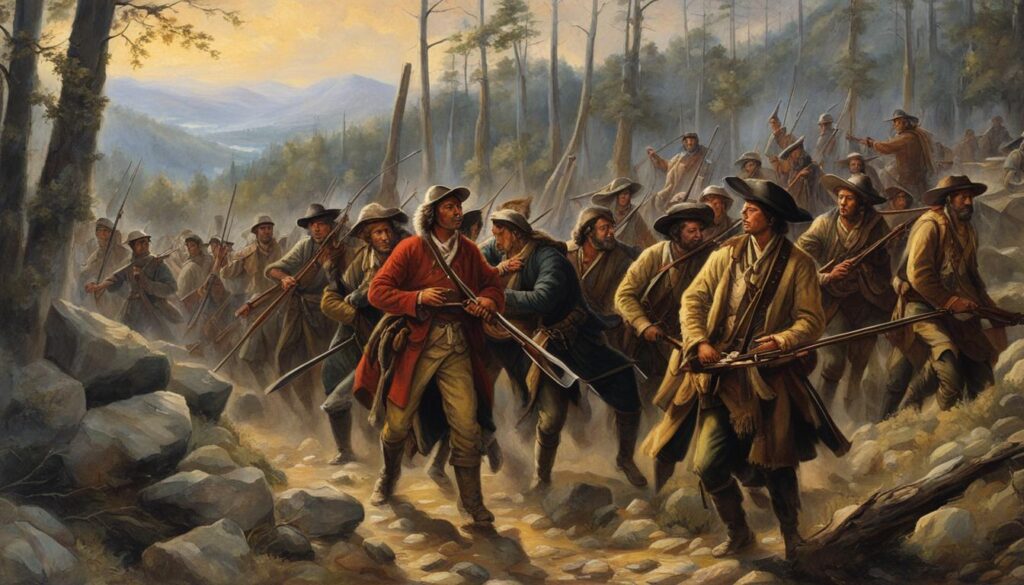
Boone’s frontier rescue and Sheltowee escape underpinned his determination to protect his people, and his actions served as a rallying cry for the settlers. As they braced for the siege, their leader’s prior experiences and ingenious escape from captivity proved pivotal. Boone’s relentless drive for freedom and his tactical cunning shaped the settlers’ defense, allowing them to repel the assault and emerge victorious against overwhelming odds.
- Daniel Boone’s capture by Shawnee warriors in 1778.
- Boone’s adoption into the tribe as “Sheltowee” (Big Turtle).
- The daring Sheltowee escape and 160-mile journey back to Boonesborough.
- Boone’s indispensable role in leading the settlers’ defense during the siege.
Ultimately, Boone’s unparalleled skill and dedication as a frontiersman and leader were instrumental in the settlers’ fairy-tale defense of Boonesborough. His unyielding resolve to protect his people from attack and reclaim their land laid the foundation for their tenacious stand against the relentless siege, ensuring that the settlement would endure and stand tall in the annals of American history.
Chief Blackfish and Shawnee Involvement
At the forefront of the Siege of Boonesborough stood Chief Blackfish, a prominent Shawnee leader who played a pivotal role in the attack. His objective was to reclaim traditional Shawnee lands that had been taken over by colonial expansion. Alongside other Native American tribes and their British allies, the Shawnees aspired to halt American encroachment into their territories and regain control. In light of the Shawnee and British alliance, the relationship between these two forces grew stronger, united by a shared goal of curbing colonial advancement.
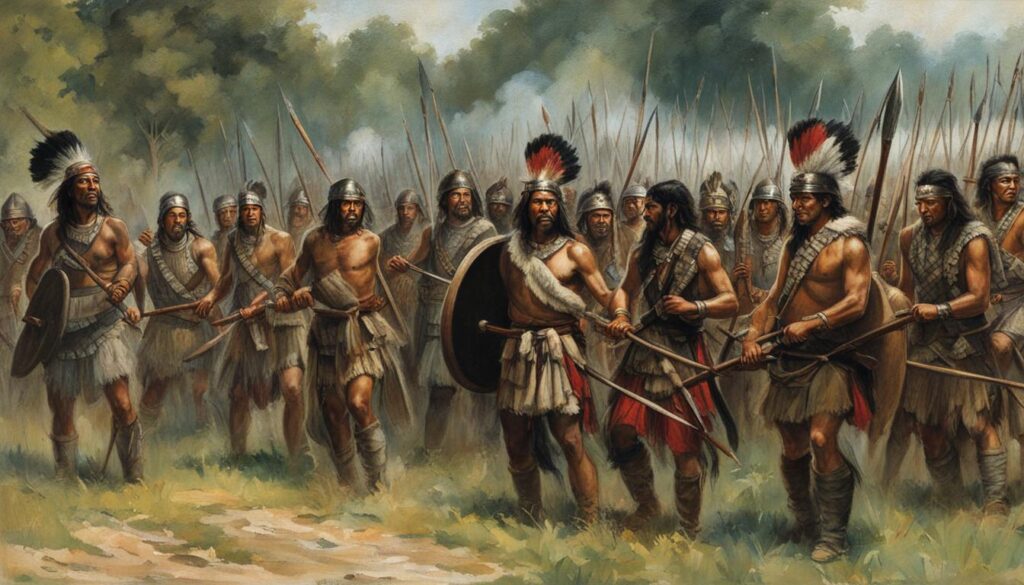
Under Chief Blackfish’s command, the assault on Boonesborough was carried out primarily by the Shawnees, forming the core of the attacking force. The Shawnee warriors, along with members from other Native American tribes, joined the fray with a sense of determination and urgency. Their involvement, driven by the significant loss of their hunting grounds, was a crucial factor in the unfolding of the siege.
“We have lost our hunting ground; we are determined to curtail American encroachment and restore autonomy over our territories.”
For the Shawnees and their Native American alliances, the Siege of Boonesborough symbolized a desperate attempt to preserve their way of life and protect the lands they held dear. With the support of the British, these tribes clashed with the American settlers, aiming to steer the tide of conflict in their favor. Despite their best efforts, however, the resolute defense of Boonesborough by Daniel Boone and his compatriots led to the eventual failure of Chief Blackfish’s forces.
Perhaps the most enduring legacy of Chief Blackfish and the Shawnee involvement in the siege is the story of bravery and resilience exemplified by all the parties involved. As history would come to show, the Siege of Boonesborough was a critical episode in the larger narrative of the American frontier, a tale filled with heroes, battles, and the ceaseless pursuit of autonomy.
Under Siege: The 1778 Attack on Boonesborough
The attack on Boonesborough involved a combination of Boonesborough battle tactics such as tunneling beneath the fort’s walls, known as “mining,” tense negotiations, and settlers displaying their resourcefulness in deceiving the enemy. The defenders put up a spirited fight, employing countermining and makeshift weaponry to hold their ground.
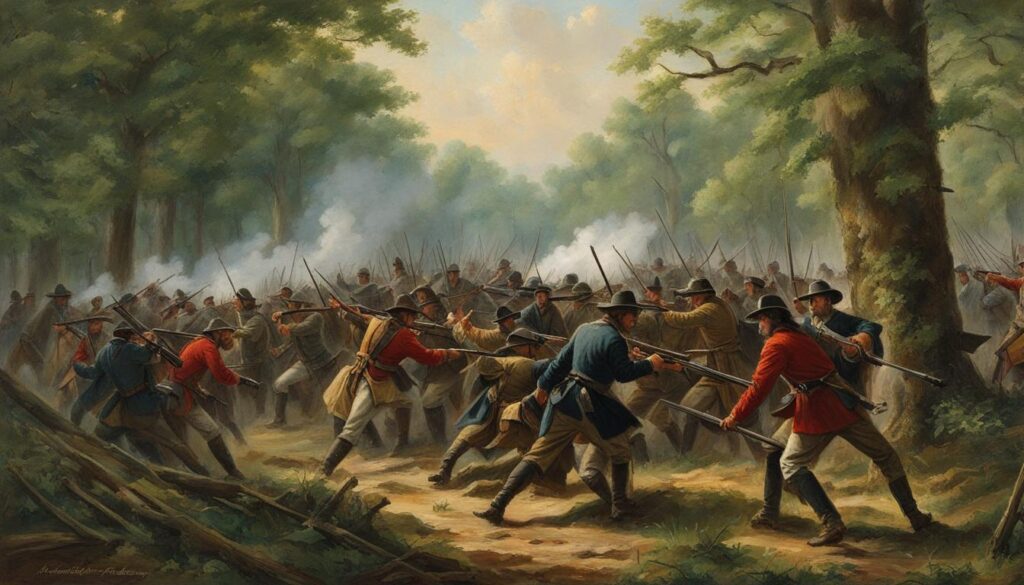
Assault Tactics and Boonesborough’s Defense
Chief Blackfish and his allies resorted to various assault tactics to try and breach the fortified settlement defense: mining and tunneling beneath the walls, distressed negotiations, and using psychological warfare. Women in the settlement even donned men’s attire in an attempt to deceive the enemy into believing the militia was larger in number.
On the defensive side, the resilient settlers and their colonial steadfastness manifested through countermining, using wooden cannons, and employing additional makeshift weaponry. In one instance, they used converted muskets to extinguish fires started by the attackers. The settlers’ ingenuity shone through during these challenging times as they were determined to protect their fortified settlement.
Behind the Barricades: Life During the Siege
Life in Boonesborough during the siege was marked by vigilance, resource management, and a silent resolve. The settlers conserved precious gunpowder and found ways to repel the attackers with minimal casualties.
Boone advised the settlers, “We are not fighting, my friends, for glory, but existence.” Daniel Boone, September 1778.
Heeding Boone’s advice, the settlers focused on the task at hand, working towards the shared goal of defending their homes. This resourcefulness and determination demonstrated the frontier resilience and colonial steadfastness characteristic of the settlers.
- Resource management: Conserving gunpowder for the critical moments of the siege.
- Vigilance: Keeping watch for any changes in enemy tactics or movement.
- Shared resolve: Maintaining a sense of community and strength in the face of adversity.
Ultimately, the settlers successfully held off the attackers by employing a combination of siege warfare tactics and staying true to their frontier resilience. As a result, the attack on Boonesborough is remembered as a testament to the ingenious defense strategies and spirited determination that defined the American frontier settlements.
Significance of Siege of Boonesborough in American Revolution
Although often overshadowed by major battles in the Eastern Theater, the Siege of Boonesborough was a pivotal event in the American Revolution’s Western Theater. This crucial confrontation highlighted the resilience and grit of the American frontier spirit and demonstrated that even under pressure, colonial persistence and determination remained steadfast. With the settlers’ successful defense of Boonesborough, the strategic objectives of both the British forces and their Native American allies were dealt a significant blow.
The Siege of Boonesborough represents not just a battle, but a test of the true American spirit in the face of adversity.
This gritty determination was critical to the progressively successful defense of the frontier, particularly in Kentucky, where colonial persistence contributed significantly to the war effort. Some key factors underscoring the importance of the Siege of Boonesborough to the American Revolution are:
- Colonial persistence in defending a pivotal frontier settlement against numerically superior forces.
- Demonstrating the ability to maintain control over contested frontier territories, despite overwhelming odds.
- Serving as a crucial setback to both British and Native American forces, dealing a psychological blow to their strategic objectives.
- Highlighting the tactics and strategies used in frontier warfare, providing a valuable insight into the conduct of hostilities in the Western Theater of the conflict.
The Siege of Boonesborough can also be viewed within the broader context of the Revolutionary War’s effect on Native Americans, who suffered greatly from the conflict. The siege, and subsequent defense, raised awareness of the various interests at play in the frontier region, further emphasizing the complex nature of this struggle, which extended far beyond the war’s binary British-American dynamic.
| Aspect of the Siege | Significance |
|---|---|
| Strategic Location | Boonesborough’s key position at the heart of the Kentucky frontier enabled the settlement to serve as a vital bastion of colonial defense. |
| Colonial Persistence | The determination and resilience displayed by the settlers of Boonesborough in their defense acted as a testament to the frontier spirit throughout the region. |
| Psychological Impact | Both the British and the Native American allies suffered a significant blow to their confidence and strategic objectives with the failure of the siege. |
| Native American Involvement | The explicit involvement of the Shawnee and other Native American tribes in the siege underscores the complexity of the Revolutionary War beyond British and American participants. |
Ultimately, the Siege of Boonesborough epitomizes the challenges faced by American settlers on the frontier and highlights the determination of the colonial population to protect their hard-won territory. As such, it remains an essential chapter in the history of the American Revolution, the broader narrative of frontier settlement, and the development of the United States.
The Aftermath of the Siege and Boone’s Court-Martial
Following the successful defense against the siege, Daniel Boone bore the brunt of a court-martial as he was accused of harboring British sympathies. These charges cropped up, in part, due to his initial capture and rumored negotiations with the Shawnee.
Richard Callaway, a respected figure with whom Boone shared a contentious past, presided over the proceedings. Despite the seriousness of the accusations, Boone’s vindication came swiftly as he was fully acquitted. The court recognized his instrumental role in repelling the siege and promoting the American cause.
In light of his exoneration, Boone received a major promotion, acknowledging his contributions to the frontier defense. Yet, this legal victory could not fully erase the blemish left on his reputation. Consequently, Boone opted to establish Boone’s Station instead of returning to Boonesborough. As if to downplay the incident, he maintained a low profile with regards to the court-martial.
“My waking hours have been almost absorbed in unpleasant reflections unless with my friends or doing something for their enjoyment. I have not been able to disengage my mind from thoughts of the court-martial.” – Daniel Boone
This ordeal serves as a somber reminder of the complexities surrounding the American frontier and the circumstances that forged its heroes. Boone’s tumultuous experience underlines the fact that even vindication can leave a lasting impact on one’s legacy. Despite the court-martial’s negative consequences, Boone’s frontiersmanship and leadership continue to shine through as pivotal aspects of the Siege of Boonesborough.
Boonesborough Today: Remembering the Siege
Boonesborough, now a site of historical significance, hosts yearly reenactments of the siege, offering a glimpse into the tense and turbulent times of the settlement. The state park aims to preserve this crucial episode in American history, with the siege featured in various cultural retellings, including literature and television, as in the 1964 CBS series “The Great Adventure.”
These reenactments at the Boonesborough historical site provide a unique opportunity for visitors to connect with the frontier heritage and better understand this pivotal event in America’s past. The state park, dedicated to commemorating the historical significance of the settlement and its defenders, offers a wide range of educational experiences that showcase life during the Siege of Boonesborough.
“The Siege of Boonesborough reenactments capture the essence of a turning point in American frontier history, allowing visitors to relive a time of high stakes and palpable tension.”
Apart from reenactments, the state park also organizes guided tours, educational programs, and special events throughout the year to further imbibe the essence of America’s frontier heritage in the minds of visitors. To enhance the experience, the park includes several amenities such as:
- Visitor information center
- Interactive exhibits
- Picnic areas
- Nature trails
- Camping facilities
Boonesborough’s enduring relevance in America’s frontier narrative continues to attract visitors from all walks of life, eager to explore the rich history it has to offer. In doing so, they pay homage to the valor of those who defended it against all odds and secured a lasting place in the annals of American history.
Conclusion
The Siege of Boonesborough stands as a testament to the unyielding spirit and resilience of early American settlers, who successfully defended their frontier settlement against the backdrop of the Revolutionary War. This historic event highlights the complex dynamics of America’s westward expansion and serves as a microcosm of the American frontier experience. It underlines the convergence of courage, strategy, and determination in the face of overwhelming odds.
The Boonesborough legacy continues to inform and inspire discussions on American identity and the commitment to exploration that defined early colonial America. The historic lessons gleaned from the Siege of Boonesborough remind us of the crucial role that frontier settlements played in shaping the country as we know it today.
Preserved through yearly reenactments and historical sites, the Siege of Boonesborough stands as a vital piece of American frontier history. It serves as a poignant reminder of the struggles, victories, and challenges faced by those who forged a new path in the wilderness, helping to broaden our understanding of America’s complex, multi-dimensional past.
FAQ
When did the Siege of Boonesborough occur?
The Siege of Boonesborough took place during the American Revolutionary War, from September 7 to September 18, 1778 in Kentucky.
Who led the attack on Boonesborough?
Shawnee Chief Blackfish, an ally of the British forces, led the attack on Boonesborough. The attacking force included 444 Native Americans and 12 militia members from various tribes, as well as Detroit French-Canadian forces.
Who led the defense of Boonesborough?
Daniel Boone, a prominent American frontiersman and former prisoner of the Shawnee tribe, led the fortified American settlers in defending Boonesborough against the assault.
What were the major events of the Siege of Boonesborough?
The 11-day siege witnessed several key events, including mining and countermine digging, militant negotiations, and a symbolic pipe smoking. Both the attackers and defenders used various tactics and strategies, showcasing the resilience and ingenuity of the American settlers.
What was the outcome of the Siege of Boonesborough?
The American settlers successfully defended Boonesborough, resulting in an American victory. Despite the victory, Daniel Boone faced a court-martial on suspicion of British sympathies but was acquitted and later promoted.
What was the significance of the Siege of Boonesborough in the American Revolution?
The Siege of Boonesborough was a crucial confrontation that underscored the resilience and grit of the American frontier settlers. Beyond being a mere skirmish, it served as evidence of American determination to retain control over frontier territories and proved to be a psychological blow to both British forces and their Native American allies.
How is Boonesborough remembered today?
Boonesborough is now a site of historical significance, with yearly reenactments of the siege held at the state park. The siege has also been featured in various cultural retellings, such as literature and television, reflecting its enduring relevance in America’s frontier narrative.

